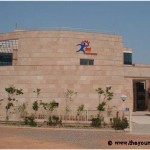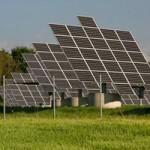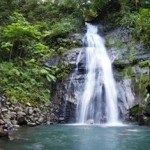
Ripples, waves and other disturbances form in the atmosphere downstream of turbines, similar to the watery wakes behind boats.
“This turbulence can damage turbines downstream, and harm productivity,” said Bob Banta, an atmospheric scientist with NOAA’s Earth System Research Laboratory (ESRL) in Boulder.
Banta and colleagues from ESRL, the University of Colorado (CU) at Boulder, Colorado, the U.S. Department of Energy’s National Renewable Energy Laboratory (NREL), and Lawrence Livermore National Laboratory have set up an experiment south of Boulder, Colorado, to create three-dimensional portraits of wind speeds and directions in turbine wakes.
Wind turbines – some taller than a 40-story building – stand ready to harness some of the wind energy at NREL’s National Wind Technology Center. The prevailing winds sweep east over the mountains and are funneled through Boulder’s Eldorado Canyon, right to the wind technology center.
“The wake effect has been modeled in wind tunnel studies and numerical models,” Banta said, “but the atmosphere is different, it’s more variable and complicated.”
Banta spent the last several years using a high-resolution, scanning Doppler Lidar to make detailed profiles of the atmosphere. For the turbine project, he hopes to capture turbulence and other wake effects in a broad wedge of air up to 7 km (4.3 miles) long and 1 km (3,280 feet) high.
The team will use the scanning lidar to take a detailed look at the atmosphere in front of and behind one of the large turbines on the NREL site: a 2.3-megawatt graceful giant that stretches 100 meters (328 feet) to the central hub, with three 45-meter (148-foot) blades.
The researchers hope to capture the effects of ramp up and ramp down events, when winds suddenly gust high or die down. They also will gather data on what happens downstream when winds shift direction quickly. Many other instruments support the project, from the “CU Windcube Lidar” that also measures wind speeds, directions, and turbulence in the lower atmosphere, to meteorological instruments on towers downwind.
“Current-generation wind turbines stretch up into a complicated part of the atmosphere,” said Julie Lundquist, project leader, Professor in the Department of Atmospheric and Oceanic Sciences at CU-Boulder and a joint appointee at NREL. “If we can understand how gusts and rapid changes in wind direction affect turbine operations and how turbine wakes behave, we can improve design standards, increase efficiency, and reduce the cost of energy.”
By the end of 2010, wind power provided 2.3 percent of U.S. electricity, up from 1.8 percent the previous year. To facilitate increased electricity production from wind, the turbulent lower atmosphere and its effects on turbines and turbine arrays must be better understood.

The wind wake study, dubbed the Turbine Wake and Inflow Characterization Study, fits under a Memorandum of Understanding on “Weather-dependent and Oceanic Renewable Energy Resources” signed by NOAA and the Department of Energy (DOE) in January 2011. The agreement sets up a framework for NOAA and DOE to work together on enhancing the accuracy and completeness of resource information for the effective and sustainable deployment, operation and maintenance, and the efficient use of weather-dependent and oceanic renewable energy technologies and infrastructure.
The wind wake study was primarily funded by DOE, NOAA and CU-Boulder and involves many collaborators, led by:
- Robert Banta and Alan Brewer, Chemical Sciences Division, ESRL
- Yelena Pichugina, Cooperative Institute for Research in Environmental Sciences
- Julie Lundquist, CU-Boulder, NREL National Wind Technology Center
- Neil Kelley, National Renewable Energy Laboratory’s National Wind Technology Center
- Jeff Mirocha, Lawrence Livermore National Laboratory
NOAA’s mission is to understand and predict changes in the Earth’s environment, from the depths of the ocean to the surface of the sun, and to conserve and manage our coastal and marine resources.
Source: National Oceanic and Atmospheric Administration (NOAA).
[Photo: A turbine at the National Wind Technology Center south of Boulder, Colorado. (Credit: CIRES)]














